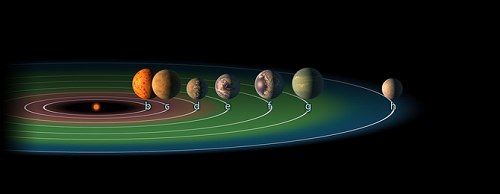NASA Telescope Reveals Largest Batch of Earth-Size, Habitable-Zone Planets Around Single Star
NASA's Spitzer Space Telescope has revealed the first known system of seven Earth-size planets around a single star. Three of these planets are located in an area called the habitable zone, where liquid water is most likely to thrive on a rocky planet. The system sets a new record for the greatest number of habitable zone planets found outside our solar system. Any of these seven planets could have liquid water, the key to life as we know it. The exoplanet system is called TRAPPIST-1 and is only 40 light-years away. Following up on the Spitzer discovery, NASA's Hubble Space Telescope has initiated the screening of four of the planets, including the three inside the habitable zone. These observations aim at assessing the presence of puffy, hydrogen-dominated atmospheres, typical for gaseous worlds like Neptune, around these planets. In May 2016, the Hubble team observed the two innermost planets and found no evidence for such puffy atmospheres. This finding strengthened the case that the planets closest to the star are terrestrial in nature. Astronomers plan follow-up studies using NASA's upcoming James Webb Space Telescope, scheduled to launch in 2018. With much greater sensitivity, Webb will be able to detect the chemical fingerprints of water, methane, oxygen, ozone, and other components of a planet's atmosphere. Webb also will analyze planets' temperatures and surface pressures — key factors in assessing their habitability.

Source: HubbleSite
- 358 reads
Human Rights
Fostering a More Humane World: The 28th Eurasian Economic Summi

Conscience, Hope, and Action: Keys to Global Peace and Sustainability

Ringing FOWPAL’s Peace Bell for the World:Nobel Peace Prize Laureates’ Visions and Actions

Protecting the World’s Cultural Diversity for a Sustainable Future

Puppet Show I International Friendship Day 2020

